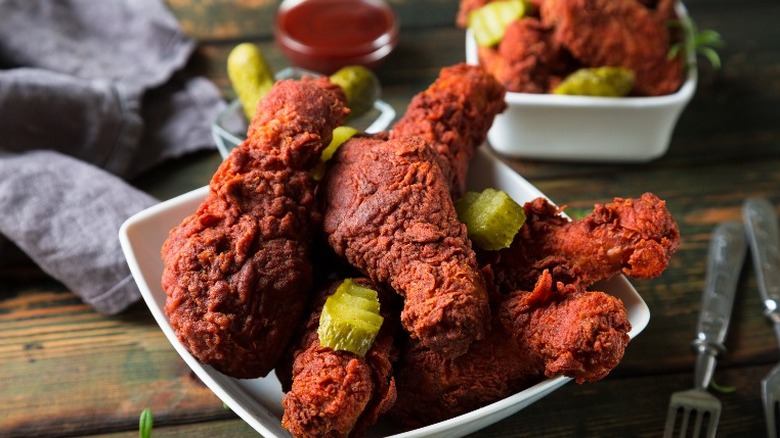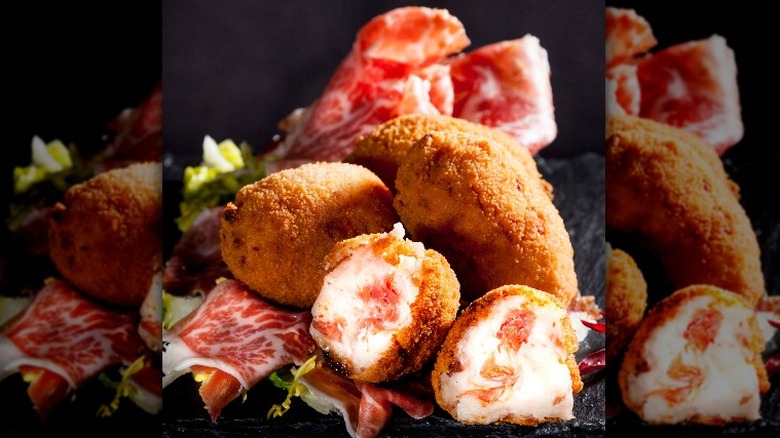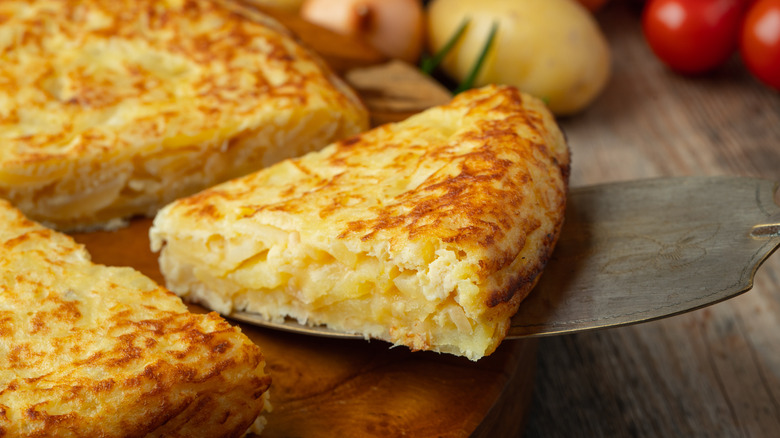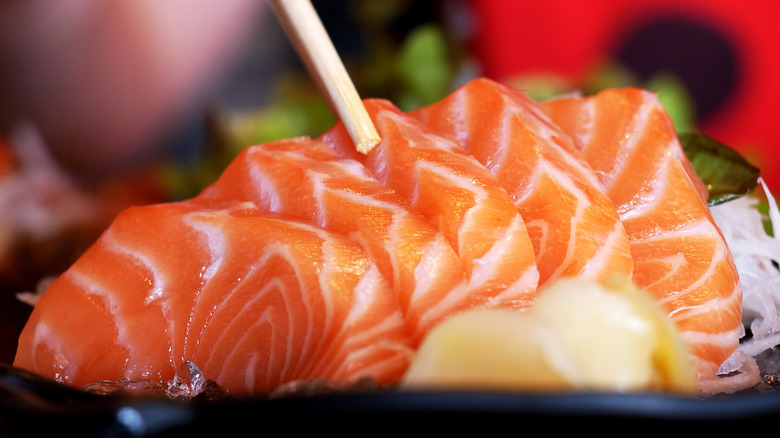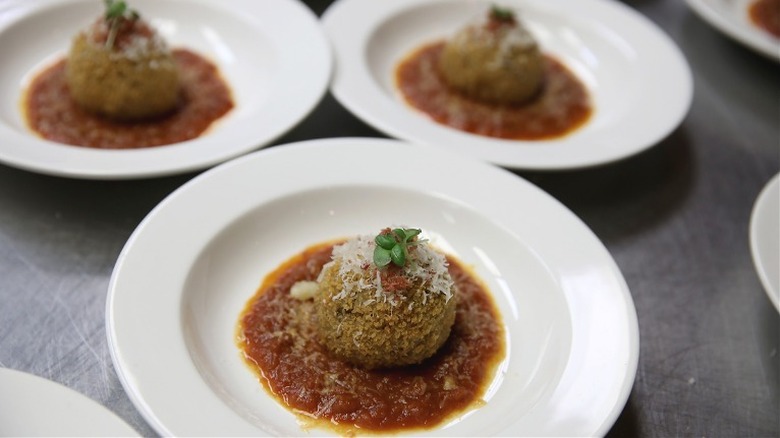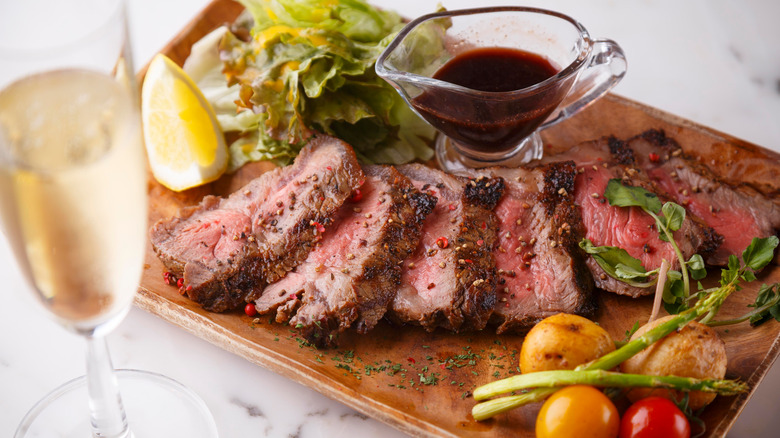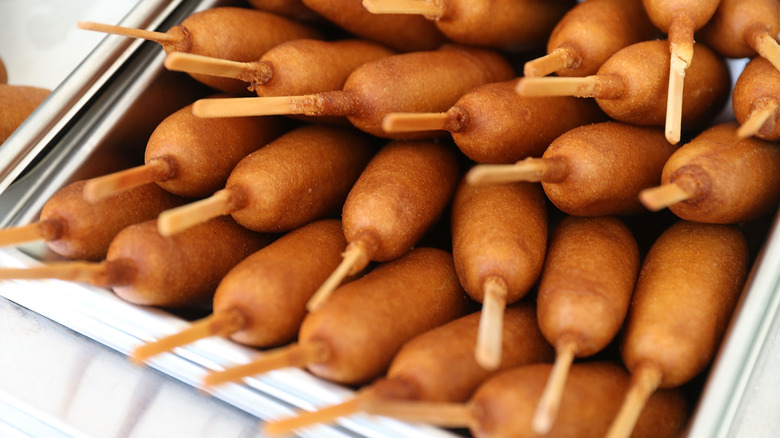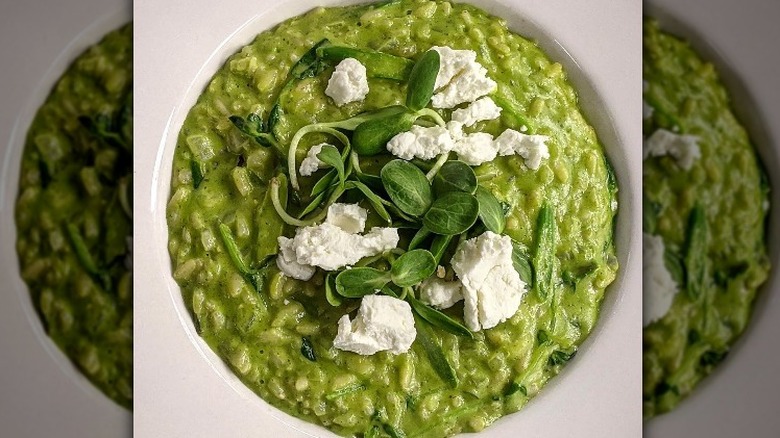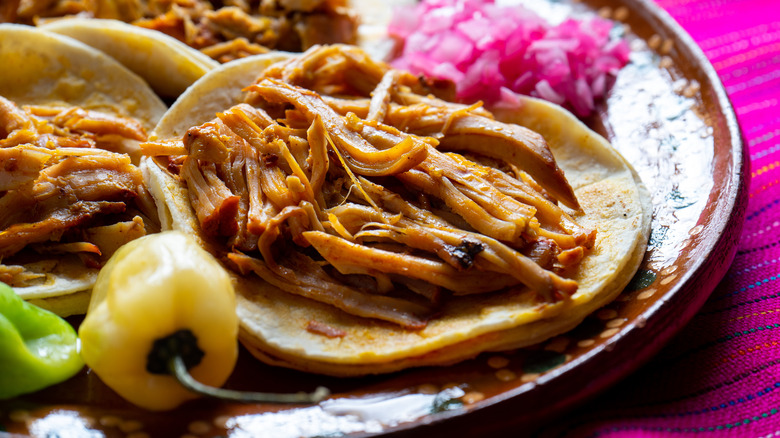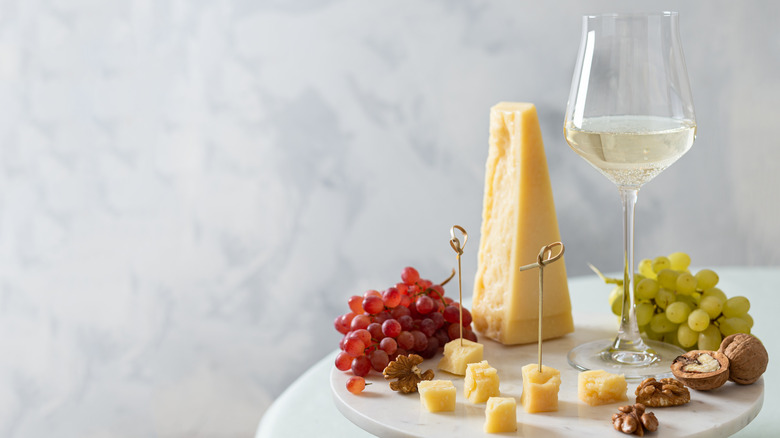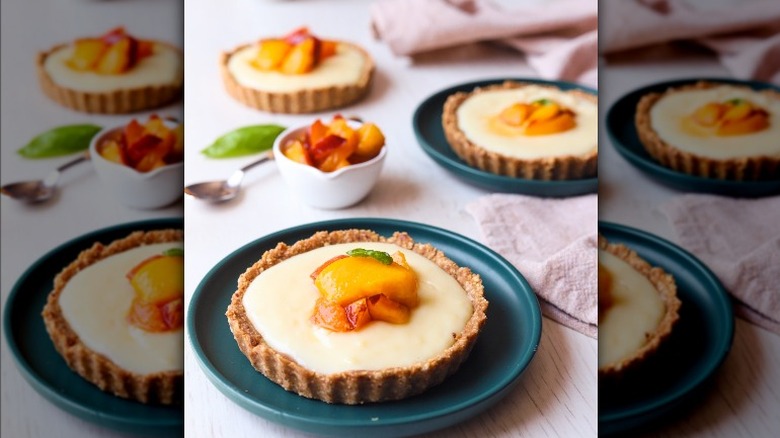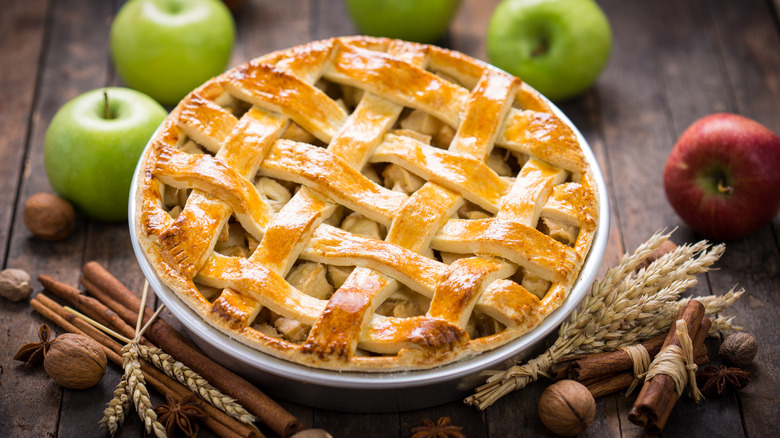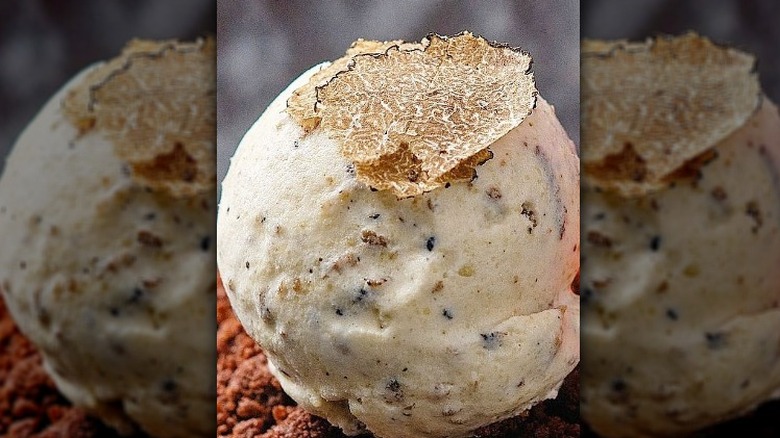13 Unconventional Foods To Pair With Champagne
There is just something about hearing the cork pop on a bottle of sparkling wine that shouts, "let's celebrate!" Whether it's a special occasion Saturday night, relaxing Sunday brunch, or taco Tuesday, enjoying a glass of Champagne, cava, crémant, or Prosecco prepares you for fun. However, many consider sparkling wine a drink for fancier occasions, serving it mainly as an aperitif to start an evening. But that couldn't be farther from the truth. The various styles of bubbly should be enjoyed daily, paired throughout your night, starting with appetizers all the way to desserts.
With similar froth and festivity, we believe anything you drink with a beer can be paired with a bottle of bubbly. Of course, there are classic wine and food pairings like Champagne with oysters or triple cream brie cheese. But sparkling wine also pairs well with hamburgers and fries, tortilla chips and guacamole, corn dogs, and funnel cakes. You may think we're totally off base, but we promise these pairings will surprise and delight you and your palate.
Hot fried chicken
Completely dry, brut Champagne and fried chicken is a great wine and food pairing. Battered, fried, and salty chicken with zippy, high acid bubbles creates a spot-on combo. But what about Nashville-style hot chicken or spicy chicken wings with peppery heat that soars off the Scoville scale?
We suggest extra dry sparkling wine. Spicy foods often go best with sweeter pairings, so how can a dry sparkling wine pair with this famously fiery entrée? The wine, in reality, is slightly sweet. Yes, it can be confusing. Decanter defines sparkling wine labeled extra dry (or extra sec for French options) as containing 12-17 grams of sugar per liter. And Wine Folly adds that the style balances fruit with freshness.
Champagne Guide explains that sugar is added to the wine during "dosage" at the end of Champagne production. The addition is a necessary step as grapes for sparkling wines are usually the first fruit harvested yearly (via Wine Institute). Picking early, before the fruit has achieved full ripeness, ensures sparkling wine's acidity is intact, locking in vibrancy and freshness. Adding sugar at the end rounds out the flavor profile.
Consider a fruit cocktail-filled extra dry Prosecco to cleanse your heated palate like Corvezzo Prosecco DOC Extra Dry. The sweetness of the extra dry wine will cut through the heat of the fiery chicken. And it won't break the bank — extra dry Prosecco is usually under $20 a bottle.
Croquettes
The only thing better than a creamy, crunchy Spanish croquette is a glass of sparkling wine with the fried fritter. Spanish kitchens throughout the country mix ingredients with bechamel sauce, which binds the elements and creates the croquette, explains Devour Tours. Traditionally, croquettes are made with ham but can include any vegetable, protein, or cheese.
The marriage of heavy cream, butter, and flour creates a velvety sauce that works as a natural complement to dry sparkling wine. The acidity in the sparkling wine cuts through the fattiness the roux-based sauce imparts.
We love smoked bacon or salt cod croquettes with Spain's answer to Champagne — cava. Combining the breadcrumb-coated, deep-fried fritter's crunch and creaminess with zesty, toasty cava is an ideal pairing.
The sparkler is crafted much like Champagne, Wine Folly notes. But with cava, the primary grapes are 100% Spanish, including macabeo, parellada, and xarel-lo (pronounced "cheryl-lo" in Catalan). The three varieties combine to create a fragrant sparkler with citrus and floral notes and a savory quality brought out by the yeasty, bready flavors the secondary fermentation imparts.
We like Villarnau Brut Reserva with its clean, focused acidity and baked pastry, golden citrus, and fresh cream flavors. The toasty, creaminess of the sparkler blends perfectly with the croquettes.
Spanish tortilla
Napa Valley's notable sparkling wine producer, Domaine Carneros, uses Old World methods in its production. All sparkling wines are made in the traditional style with the second fermentation creating the carbonation for all the bubbles in the bottle (it's also known as the "méthode traditionnelle"). The fruit is grown sustainably in the cool climate of Napa Valley's Carneros region.
Though rooted in the classic style, the winery loves to create out-of-the-box pairings for guests during its "Bubbles and Bites" tasting. Bringing together unexpected yet utterly spot-on pairings ignites the imagination and palates of visitors to the winery. The winery is currently featuring sparkling pairings with a Spanish flare. Tasting Table asked the winery's CEO, Remi Cohen, for her favorite pairing with the winery's Brut sparkling wine.
Cohen shared that the perfect pairing with Domaine Carneros Estate Brut is tortilla española, a classic Spanish torta omelet made with thinly sliced potatoes and onion. Cohen adds, "we like to show the versatility of sparkling wine." The dish highlights the cohesiveness of Domaine Carneros's sparkling selections when paired with international flavors. She says, "the creaminess of the omelet complements the rich yeasty character of the wine." The winery finishes the tortilla with a rojo and verde mojo, two zesty sauces that she believes lift the fruity citrus notes out of the complex wine.
Tataki and sashimi
Sushi and Champagne are a match made in heaven. You can't beat sparkling wine with fresh fish, whether you prefer your dish sashimi or tataki style. The difference between tataki and sashimi lies in how the sliced fish is served — sashimi is entirely raw and tataki is lightly seared. Michelin Guide explains that pairing wine with fatty fish requires acidity.
You're in luck, as acidity is one of the feature characteristics of sparkling wine. We suggest an extra brut sparkling wine with raw fatty otoro, ahi tuna, or salmon sashimi. This style of sparkling wine does not have any sugar added during dosage. It is a sparkling wine in its purest form, explains D.O Cava, like our favorite from Rias Baixas, Spain — Mar de Frades Brut Nature Sparkling Wine.
The region sits on the edge of the Atlantic Ocean, where salty sea breezes blow through albariño vineyards planted in granite and schist soils. Wine Folly explains that the variety creates wines with a round, slightly weighty palate with salty, citrus, and stone fruit flavors. Melding the fruity palate with the structured character the soils provide creates a textured sparkler.
These features also make the wine ideal for serving alongside tuna, swordfish, or salmon tataki with a citrusy, umami-filled ponzu, like our blood orange ponzu sauce.
Arancini
Mac and cheese is a solid go-to pairing with a yeasty, zesty, dry, brut-style sparkling wine. With a similar starchy, creamy flavor, consider the Italian favorite, arancini, or fried risotto balls.
Originating in Sicily, the snack is named after the Italian word for orange (or "arancia"), the shape of the fried treat, Best of Sicily reports. The gooey rice balls are often stuffed with meat or cheese and served with a rich tomato sauce. The sauce's acidity and the rice ball's fatty saltiness will soften the edge of the wine, bringing out the fruity flavors and freshness. We like to pair it with a classic method sparkler from Italy.
Italy may be best known for Prosecco, but in the northern Lombardy region of Franciacorta, sparkling wines are produced from the same varieties as Champagne. These include chardonnay, pinot noir, and pinot meunier. The area also produces pinot blanc.
Zero dosage (or pas dosé style) Franciacorta is a crisp, lively wine that is dry, naturally fruity, and luscious with yeasty brioche flavors. We suggest Bellavista Pas Dosé or Ca' del Bosco for a delectable union with the crumb-coated arancini.
Steak
Though you may think that pairing Champagne with red meat is a bit strange, the combo makes a tasty partnership. Ruth's Chris Steak House shares that the acidity in the sparkler cuts through the fattiness of the beef. With a dry palate, well-rounded body, and structured complexity, a brut style Champagne is best. The steakhouse adds not overcook your beef — medium-rare steak is best with Champagne. We love steak with refined Bollinger Brut or Ruinart Brut, each offers a well-rounded, full palate that cuts through the rich protein.
With this beefy logic, hamburgers, tri-tip sandwiches, and Philly cheese steaks will also pair perfectly. Glass of Bubbly agrees — pairing an Angus beef burger with vintage English sparkling and brut nature Champagne makes for an enjoyable combo.
When pairing with a Philly cheese steak, KPCC radio says to stay away from a bold red wine as it will overpower the sandwich's oniony, cheesy condiments, muddling the flavors. Instead, the acidity of Champagne will cut through the fatty richness of the dish. The yeasty brioche notes in brut Champagne will also meld with the bread roll, rounding out the flavor profile.
Corn dogs
Nothing quite says state fair food like corn dogs (although candy apples are a close second). The ultimate carnival treat, salty hot dogs are dipped into sweet cornbread batter, fried to perfection, and served on a stick. Yes, please!
To pair, the fatty, greasy dogs need something palate cleansing to cut through the richness. Brut Champagne is the perfect option. Brut wines have crisp acidity and lean minerality, which complements the fatty dog. If the corn dog is too low-brow for your fancy glass of Champagne, you can always elevate the experience by dipping your dog in 24-karat gold, like Dallas restaurant Corn Dog With No Name.
Yes, we love it with the good stuff. But, when the French specialty is too high-end for Sunday night dogs, we look to other regions of France, like the Loire Valley. Just to the west of Paris, the Loire Valley surrounds the banks and tributaries of the Loire River. In the region's center, quality sparkling crémant de Loire is made in the traditional method, creating wines that meld energy with delicate elegance.
Chateau Langlois Brut Crémant de Loire blends chenin blanc, chardonnay, and cabernet franc from the Loire Valley's Samur region. Grapes are grown in limestone soil, lending an added crushed stone mineral note to the aromatic, expressive wine.
Asparagus risotto
Healthline shares that eating asparagus can help with weight loss, lower blood pressure, and deliver a blast of nutrients like vitamins A, E, C, and K.
However, Bon Appetit reports that asparagus is one of the most challenging vegetables to pair for any chef or sommelier. Apparently, the vegetable contains an organosulfur compound which unfortunately makes wine taste like rotten eggs. Yet, asparagus remains a steakhouse favorite served grilled, roasted, steamed, and folded into creamy risotto, or a slightly healthier cauliflower rice risotto.
Sparkling wine comes to the rescue. We like the veggie with a Prosecco Superiore DOCG from the rolling hills of Conegliano Valdobbiadene within Italy's northeastern Veneto region. Prosecco is made using the Charmat method, with the second fermentation occurring in large vats. This production style ensures the sparkling wines have a youthful freshness, accentuating the natural sweetness of the asparagus.
We love Sommariva Prosecco Superiore Brut DOCG and Perlage Cahan Spumante Brut. Each is clean and complex, bringing together subtle minerality, ripe fruitiness, and soft herbal notes. The wine will lift the palate and help cut through the dish's luscious texture and creamy flavors.
Pibil and tortillas
The traditional Mayan dish, pibil, originates in the Yucatan Peninsula and is traditionally made with pork. It's also Remi Cohen's second favorite sparkling wine pairing, this time with the winery's Domaine Carneros Brut Rosé. The citrus, herbs, and spices used in the pibil meld with the fruity, berry, and stone fruit notes of the brut rosé sparkler.
New York Times adds that pibil begins by smothering a whole pig, or pork shoulder, in orange juice, spices, and annatto seed paste which imparts intense flavor and a vibrant yellow color. The pork is then wrapped in banana leaves and traditionally buried in a smoldering pit for many hours. Our version of cochinita pibil is a slightly easier option that allows you to slowly roast the pork in an oven.
The winery featured a version with chicken, traditional annatto seeds, cumin, oregano, and garlic all served on a fried corn tostada. The rosé sparkling wine begins with aromas of wild rose and stone fruit, followed by a dry, red berry fruit palate and a toasty note of baked bread. Pairing the pibil with the rosé, Cohen adds, "balances the complex spicy character of the dish to delight the senses."
We asked about guests' reactions to the winery's unpredictable pairing combinations. Cohen says, "It has been exciting to see people discover that sparkling wine's beautiful acidity makes it such a food-friendly choice."
Salty cheese
Champagne with creamy cheese, like brie or camembert, makes for a typical pairing. But salty, complex cheese pairs just as well — as does our classic cheese fondue. You can't go wrong with an old vintage brut style sparkling wine for well-aged parmesan, gouda, or cheddar. Well-known for their creamy contributions to America's dairy aisles, Wisconsin Cheese believes the buttery, nutty characteristics in aged cheese meld with the bready, nutty notes of aged Champagne. We like seven-year bottle-aged Moet & Chandon Grande Vintage Brut Champagne with its nutty hazelnut and slightly dried apple characteristics.
When penicillin-filled stilton, Roquefort, or gorgonzola arrives on the table, we recommend popping a bottle of slightly sweet extra dry sparkling wine. The intense, funky, pungent aromas and flavors are lifted with subtle sweetness, creating harmony with the moldy cheese. Wisconsin Cheese recommends a creamy blue, like gorgonzola, with Prosecco Rosé DOC.
But we also like it with Pasqua Prosecco Rosé DOC Extra Dry. Crafted in the Charmat style with a focus on freshness, the wine is a blend of glera and pinot noir. Incredibly light with a subtle sweetness that exudes notes of wildflowers and red berries, the wine perfectly balances the salty, potent blue cheese.
Stone fruit tarts
Finding the right sparkler to pair with dessert can be challenging. Overly sugary sweets can make a sparkling wine taste acidic and bitter. Conversely, sweet sparklers can become cloying when paired with a sugary dessert. However, seasonal stone fruit like peaches, nectarines, plums, and apricots are excellent options for pairing with sparkling wine.
Tasting Table asked Kelli Gregory, vineyard manager and grower relations for Adelshiem Vineyard in Willamette Valley, to share her favorite summer pairing combination. For Gregory, the ideal summer treat is a summer peach frangipane tart with vanilla-infused crème fraiche paired alongside the Adelsheim Blanc de Blancs. The 100% Chardonnay sparkling wine melds exuberant energy and freshness with a well-rounded palate thanks to an extended five-year aging time.
With flavors of orchard fruit with nutty hazelnut, Gregory says, "the Adelsheim Blanc de Blanc is a perfect compliment to this summer dish. It brings the savory crust, creamy custard, and juicy peaches together thanks to its vibrant acidity that dances alongside the crème. It creates a lovely tension between sweet and savory with structure and an elevated sense of summer yum!" Let's raise a toast to summer yum!
Apple pie
Americans have a love affair with apple pie. Though the Fourth of July staple has European origins dating back to the 14th century, today it is the classic all-American dessert, reports Food52. There is even a national holiday. (National Today confirms it's May 13, just in case you need to mark your calendar.)
For pairing, we'll travel to France and toast with the oldest sparkling wine produced in the world — and it's not Champagne. The original sparkling wine was first produced in the Limoux region within Languedoc, France.
As the story goes, Dom Pérignon was visiting the Benedictine monks at the Abbey in Saint-Hilaire, credited with crafting the first sparkling wines in the 1500s, shares The Baltimore Sun. They were producing sparkling wines years before the process began in Champagne. Dom Pérignon perfected the technique in Champagne, leading to the quality and cost of the product today.
On the other hand, Limoux offers incredible wines made in this style for a great price (usually under $20 a bottle.) We suggest a blanquette de Limoux, like Saint-Hilaire Blanquette de Limoux Brut. The traditional method sparkler predominantly uses mauzac, a native variety filled with tart green apple flavors, The Globe and Mail notes. That makes it ideal with apple pie.
Consider making apple turnovers instead of a whole pie, like our fried apple hand pies. Frothy Limoux will cut through that flaky, fatty, fried goodness. And, it bears repeating — sparkling wine loves fried food.
Truffle ice cream
For an indulgent gastronomic treat that is slightly sweet and slightly savory, consider black truffle ice cream with blanc de noirs. This is the ultimate dinner party dessert to impress your guests. But a quick note: we're referring to the uncinatum and aestivum tubers, not the sweet chocolaty spheres.
Aromatic black truffle, cream, and vanilla fall into perfect harmony with the earthy, mushroom-rich rusticity of a traditionally made sparkler crafted from pinot noir and pinot meunier. We like Argyle Blanc de Noirs Brut from Willamette Valley, Oregon. For the ice cream, we prefer the black truffle over the white truffle, first for the cost. White truffles are incredibly expensive — more so than black truffles.
But also, the flavor is better for a sweet and savory dish.
White truffles have pungent garlic, onion, and oaky aromas, shares D'artagnan. Black truffles have much more subtle aromas with a slightly sweet, wild mushroom, cacao, and caramel flavor, the purveyor adds. And, as black truffles are grown worldwide, the likelihood of you getting your hands on them is also much higher.
The blanc de noirs meld harmoniously with black truffle ice cream, exuding aromas of red cherry and apple, creamy marzipan, and forest-floor earthiness. With a completely dry palate, it is structured, complex, and precise, elevating the richness of the loamy, creamy treat.

